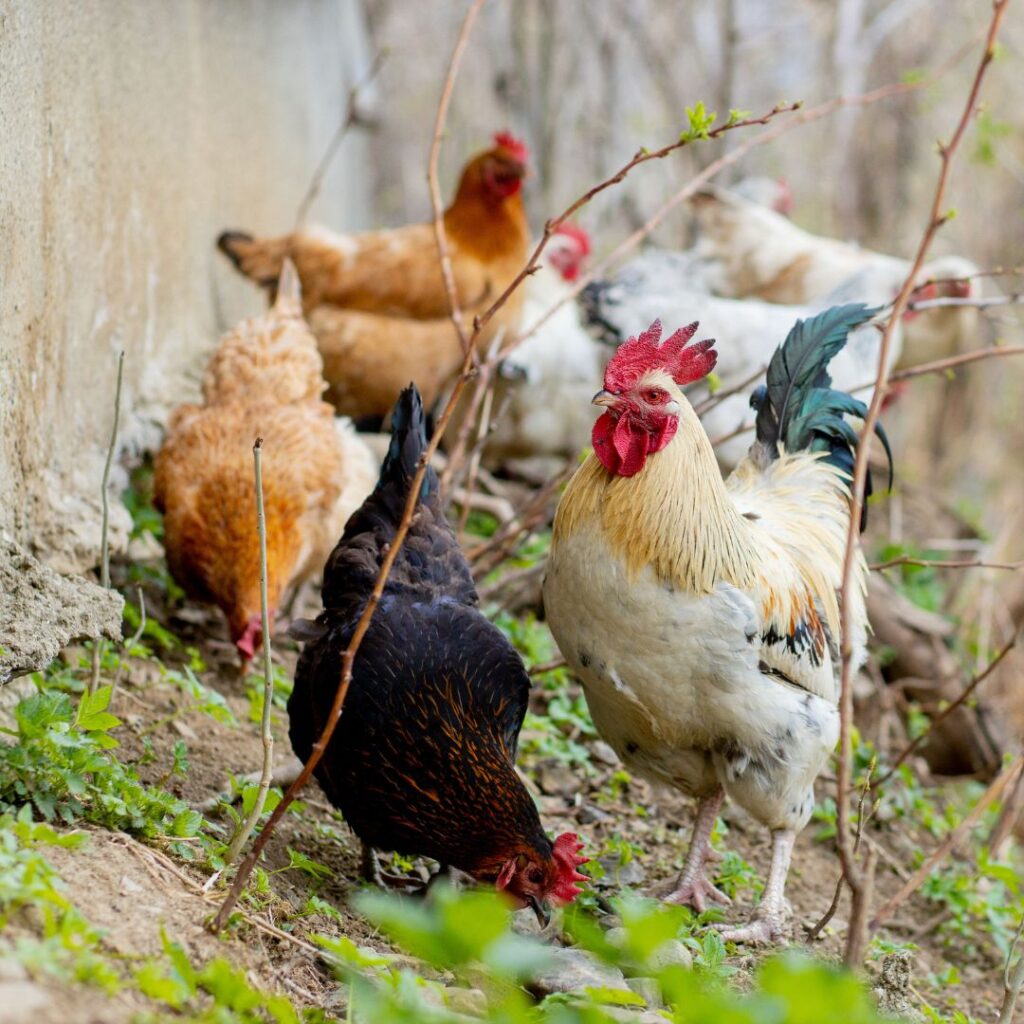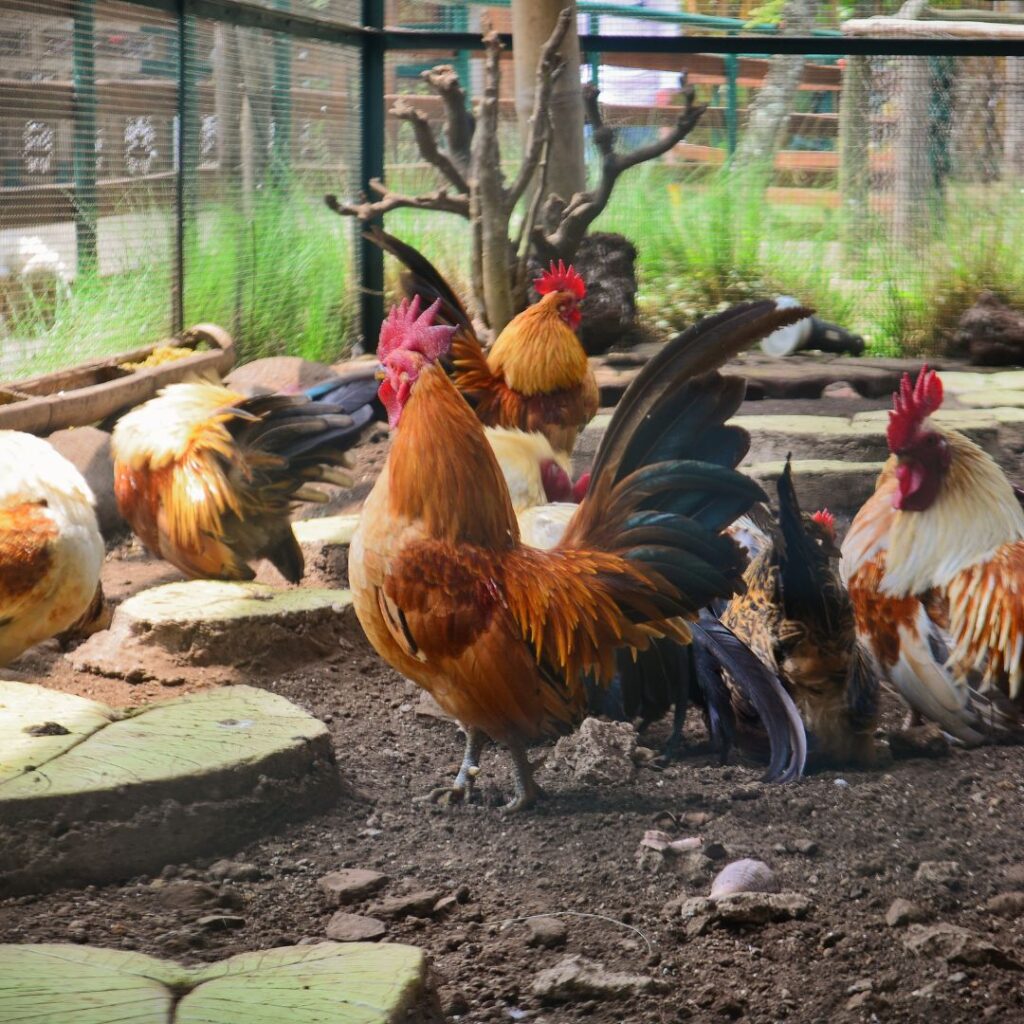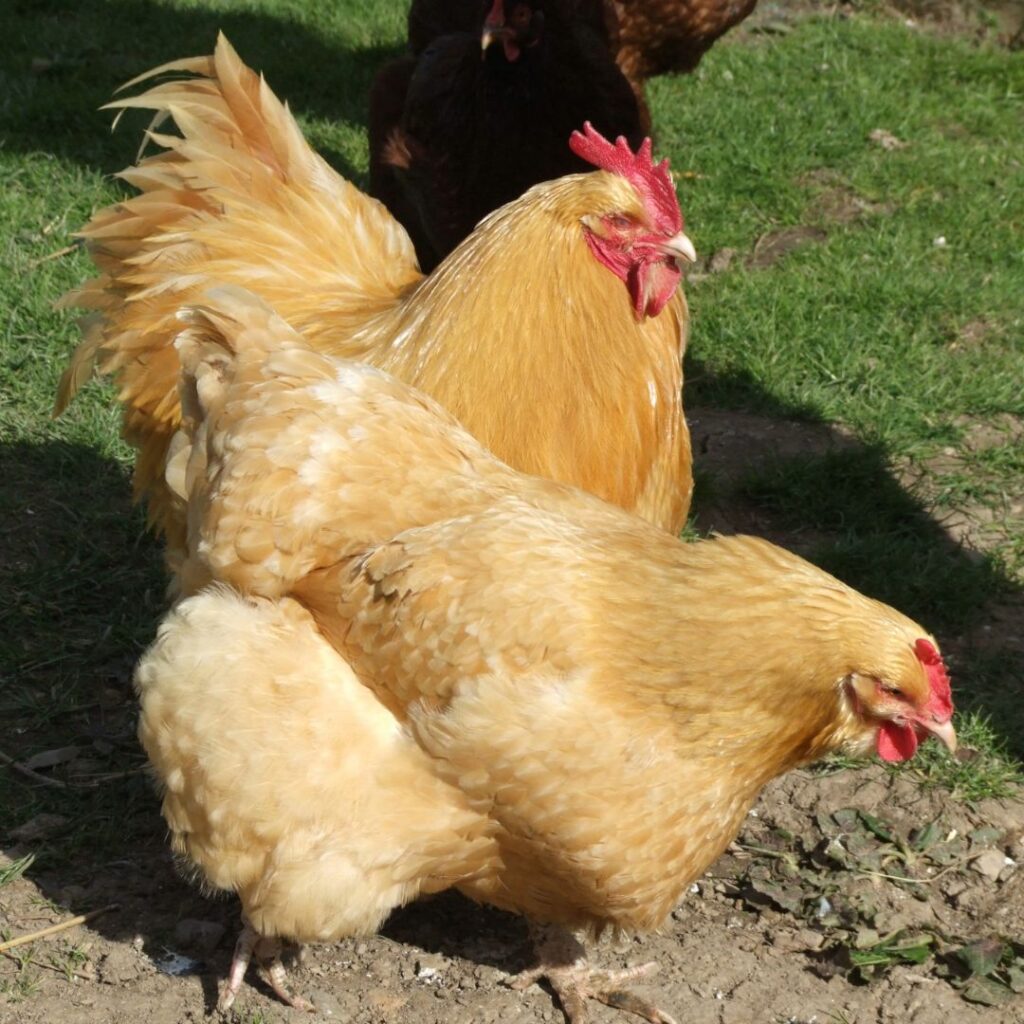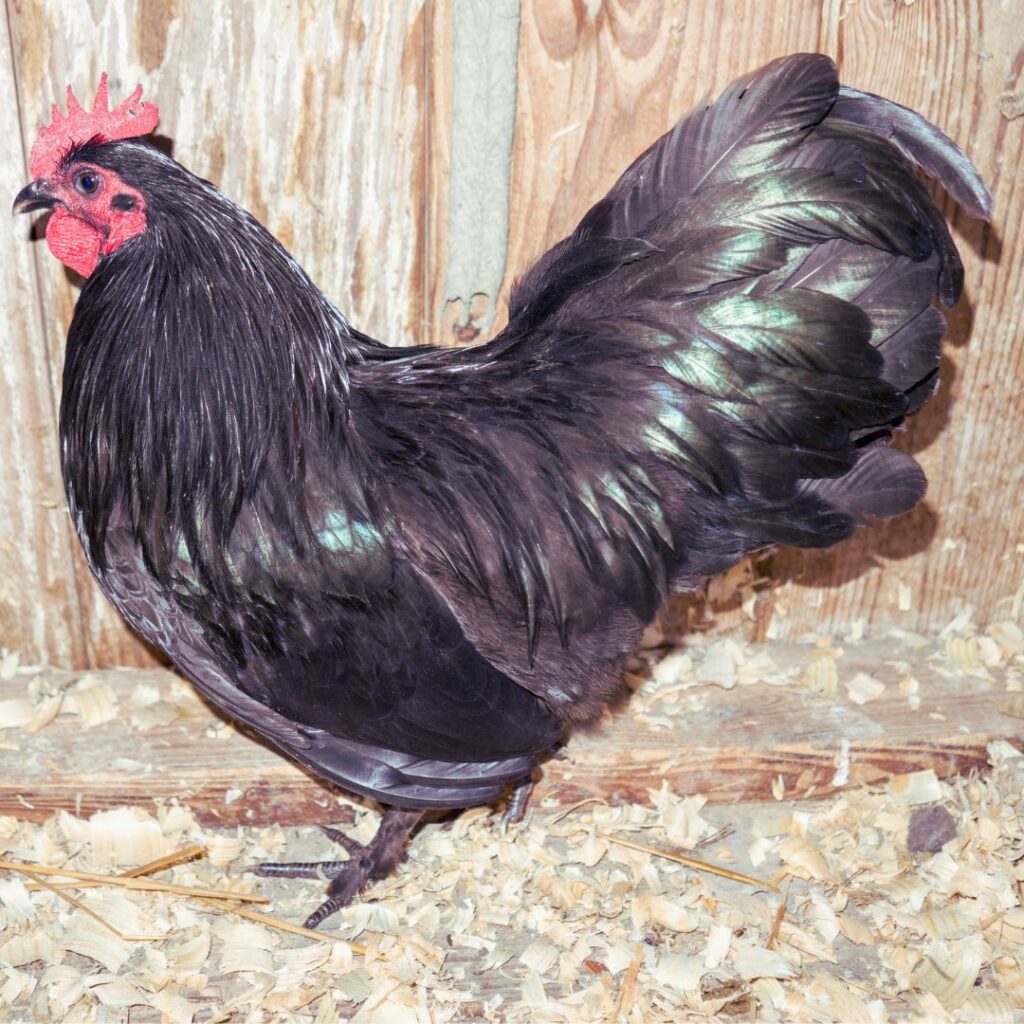Rooster to Hen Ratio; why is it so important? Raising chickens in a backyard flock or on a farm can be a rewarding experience, but it’s essential to understand the ideal rooster-to-hen ratio for a harmonious and productive environment. This ratio plays a significant role in maintaining balance in your flock, ensuring proper egg fertilization, and preventing aggressive behavior amongst the birds.
As you plan your flock, it’s crucial to consider factors such as breed, space, and the purpose of keeping chickens, whether for eggs or meat. At the same time, you should aim for the optimal ratio, which, according to studies, is about ten hens per rooster. This may vary slightly depending on certain breeds and specific circumstances.

In the following article, we will go further into the importance of maintaining the proper rooster-to-hen ratio and address potential issues if the balance is off. The information provided will serve as a guide to help you make informed decisions and ensure a thriving, healthy flock for years to come.
Rooster to Hen Ratio Fundamentals
When managing a flock of chickens, it’s important to consider the correct rooster-to-hen ratio. This balance ensures a happy and productive chicken coop. As a chicken keeper, your goal should be to maintain an optimal ratio to promote efficient egg production and healthy flock dynamics.
The generally accepted ratio is ten hens for every one rooster. However, the ideal ratio for your flock will depend on the specific breeds and the total number of hens. Lightweight and active breeds, such as Leghorns and Fayoumis, can have a higher hen-to-rooster ratio of 12:1.
Some roosters, like Rhode Island Reds, Easter Eggers, and Ameraucanas, are known to be more aggressive toward other roosters and can be rough with hens. In these cases, a minimum of three or four hens per aggressive rooster might be necessary to prevent such issues.
For optimal breeding, strive for a ratio of ten hens for every rooster. This helps ensure the young rooster has enough hens to mate with and prevents overbreeding. Remember that the ideal ratio might vary depending on factors such as breed and age of the birds.
Finding the perfect hen-to-rooster ratio may require trial and error and adjusting to your flock’s unique characteristics. Monitoring the behavior of your chickens closely will enable you to make the necessary changes to maintain a harmonious, efficient, and productive poultry coop.
Breeding and Fertility

When it comes to breeding chickens and ensuring fertility, the ratio of roosters to hens plays a crucial role. Each breed has a particular optimal mating ratio, which helps produce fertile eggs and achieve a successful hatching process.
Mating Process
To begin, it is essential to consider the age and sexual maturity of your birds. Young roosters usually reach sexual maturity between 4 to 5 months of age, while hens mature at around 5 to 6 months. This is the ideal time to start the breeding process.
Once your roosters and hens are of the appropriate age, you must determine their breed’s optimal ratio. For example, Leghorns have a mating ratio of twelve hens to one rooster, while bantam Silkies require a ratio of 6 hens to 1 rooster. This ensures that most of the eggs laid by your hens will be the fertilized eggs.
During mating, the rooster performs “treading,” which involves holding the hen’s neck feathers and stepping on her back to transfer sperm. It is crucial to monitor this process, as an inadequate ratio or overly aggressive male roosters can cause stress or injury to your hens. There is also size to consider, a large Jersey Giant Rooster would not do well with a smaller White Leghorn hen.

Once fertilized, hens will typically lay eggs within 24 to 48 hours. Remember that if a new younger rooster is introduced, it may take about 2 to 3 weeks for the hens to begin laying eggs fertilized by the new rooster. This is due to the hen’s reproductive cycle and the time taken for the sperm from the previous rooster to be replaced.
To increase the chances of hatching fertile eggs, providing a clean and comfortable environment for your hens to lay their eggs is important. Proper incubation techniques and maintaining optimal temperature and humidity levels are also crucial for the successful hatching of fresh eggs.
By understanding the breeding process, the specifics of how many hens per rooster for your breed, and factors affecting fertility and hatching, you can confidently and effectively manage your flock’s breeding and fertility.
Managing Your Flock

Pecking Order and Hierarchy
Understanding the pecking order of own flock is crucial to maintaining harmony among your chickens. The pecking order helps establish a ranking system, which affects access to food, water, and roosting spots. As a flock owner, you should monitor your flock’s behavior to identify potential issues and intervene if excessive bullying or fights occur.
Space
Providing enough space for your chickens is essential in preventing territorial disputes and maintaining a healthy flock environment. Ensure you allow a minimum 3-4 sq. ft. of space per chicken in the coop, aka the hen house and at least 10 square feet per bird in the run. This will help minimize stress among your flock and reduce the likelihood of fights over territory.
Territory
Chickens can be territorial creatures, which is why defining territories in your backyard will contribute to the well-being of your entire flock. Ensuring that each chicken has sufficient space to roam enables the natural hierarchy to develop without excessive conflict. Providing multiple food and water stations is also a good idea, reducing the chances of chickens fighting over access to resources.
Coop Management

Proper coop management is fundamental to the happiness and health of your backyard chickens. Regularly clean the coop, maintaining adequate ventilation and dry bedding. Additionally, monitor your flock for signs of illness or stress and intervene when necessary. A safe, comfortable living environment will help your chickens thrive and create a more harmonious backyard flock.
Remember that managing your flock involves the following:
- Monitoring their behavior.
- Ensuring adequate space and territory.
- Maintaining a clean, safe coop environment.
Addressing these aspects can help create a happy, healthy, and stress-free home for your backyard chickens. Find out all the tips you need if you are new to raising chickens.
Chicken Breeds

When raising chickens and keeping roosters understanding the different breeds and their behavior is essential for maintaining a healthy and harmonious environment among your hens and roosters. In this section, we will look at various aspects of chicken breeds, such as aggressive and submissive breeds, and some popular choices of roosters and hens.
Aggressive and Submissive Breeds
Some chicken breeds are naturally more aggressive than others. It is important to consider this when planning your flock, as aggressive roosters may cause injuries or stress to hens, and inadequate space can exacerbate these issues. Rhode Island Reds, for example, are known to be more aggressive. Conversely, some breeds, like Silkies, are known for their submissive and docile behavior.
In any flock, a “head rooster” or dominant rooster typically takes charge and provides security for the hens. Recognizing the signs of dominance and aggression among your birds is crucial for maintaining order and preventing damage to your flock.
Popular Rooster and Hen Breeds

Different chicken breeds have varying ratios of hens to roosters that work best to maintain balance within the flock. Here are a few popular breeds and their ideal hen-to-rooster ratios:
- Leghorns: These active and lightweight birds generally work well in a 12:1 hen-to-rooster ratio.
- Bantam Silkies: Known for their calm temperament, these small birds do well with a 6:1 ratio.
- Turkeys: As a larger bird, heavy breeds like broad-breasted Bronze turkeys have a recommended 4:1 ratio.
- Orpingtons: These gentle birds, including Buff Orpingtons and Ameraucanas, typically follow a 10:1 ratio.
In addition to these breeds, other popular choices for backyard flock owners include Easter Eggers and Ameraucanas, both known for their beautiful and unusual egg colors.
Remember, the specific needs of your flock will ultimately depend on factors such as breed, age, and energy level. Understanding the different chicken breeds and their ideal hen-to-rooster ratios ensures a thriving and well-balanced environment for your birds.
Here is a partial list of breeds (with links to more details) and the recommended hen-rooster ratio. If you want to have a sustainable flock, you’ll want to know how many roosters to have for your hens.
| Breed Name (with links to detailed articles) | Hen to Rooster Ratio |
| Ameraucana | 9:1 |
| Araucana | 4:1 |
| Australorp | 10:1 |
| Ayam Cemani | 8:1 |
| Barnevelder | 7:1 |
| Barred Plymouth Rock | 6:1 |
| Bielefelder | 12:1 |
| Brahma | 8:1 |
| Buckeye | 9:1 |
| Cochin | 6:1 |
| Cornish Heritage | 8:1 |
| Cream Legbar | 12:1 |
| Delaware | 10:1 |
| Dominique | 10:1 |
| Easter Egger | 10:1 |
| Golden Comet | 10:1 |
| Jersey Giant | 9:1 |
| Langshan | 6:1 |
| Leghorn | 12:1 |
| Marans (Black Copper) | 8:1 |
| Mille Fleur | 6:1 |
| Naked Neck aka Turken | 10:1 |
| New Hampshire Red | 10:1 |
| Olive Egger | 10:1 |
| Orpington | 9:1 |
| Polish | 7:1 |
| Rhode Island Red | 10:1 |
| Sebright | 6:1 |
| Silkie | 6:1 |
| Speckled Sussex | 10:1 |
| Welsummer | 9:1 |
| Wyandotte | 9:1 |
Egg Production and Laying

Egg production depends greatly on the ratio of hens to roosters in your flock. Maintaining the right balance is crucial to ensure the best results. Studies have shown that a ratio of 8-9 hens per one rooster provides the highest rate of egg-laying and reproduction. As a general guideline, you should maintain around ten hens per rooster for optimal results.
When your hens are laying, they produce about one egg daily. As the caretaker of your flock, it’s essential to know the factors that may impact your hens’ egg-laying capabilities. External factors such as weather conditions and extreme summer heat can lead to a reduction in egg production. Proper management of these conditions will help keep your hens comfortable and maintain a steady egg-laying rate.
It’s important to note that having too many roosters in your flock may cause stress on your hens, directly affecting their egg-laying. Even if you don’t witness any noticeable issues or conflicts, the underlying stress could lead to a decline in egg production. Reducing the number of roosters might help your hens feel more at ease and improve their egg-laying capabilities. Did you know many breeds just won’t lay in the winter months? Some will lay with some help. You can read more about that here.
As your flock matures, you might observe changes in their egg production. Hens typically produce eggs for three to four years, with each year showing a decline in production levels. Additionally, you may notice an increase in egg size and a decrease in shell quality over time.
Maintaining the optimal rooster-to-hen ratio, understanding external factors, and ensuring the well-being of your flock are crucial steps to maximize egg production and laying. Keep these factors in mind as you manage your flock, and you should be able to get the most out of your egg-laying hens.
Protecting Your Flock; How many roosters do you need?

As backyard chicken keepers, it’s essential to maintain a balance between your roosters and hens. Keeping a proper rooster-to-hen ratio ensures that your flock benefits from the love and security that roosters provide while preventing unnecessary stress on the hens.
An ideal rooster-to-hen ratio is generally ten hens for every rooster. This number can be different depending on the breed, with more active breeds like Leghorns having a higher 12:1 ratio. Maintaining this balance will allow your rooster to protect the hens and help encourage healthy egg-laying effectively.
Ensuring that your flock has ample space to roam and exhibit natural behaviors is essential. Aim for at least 3 square feet of coop space per hen and 10 square feet of outside run space. Providing adequate space prevents overcrowding and allows your chickens to live harmoniously.
Security is a significant concern for all backyard chicken owners. Your rooster is critical in warning and protecting the flock against potential predators. They are adept at sensing threats and alerting the hens, allowing them to seek shelter.
To further protect your chickens from predators, ensure that the coop and run are securely enclosed with sturdy fencing. Regularly inspect the area for signs of digging, damage, or entry points, and promptly address any issues. Installing motion-activated lights and considering a guard animal, such as a dog or guinea fowl, can add additional layers of security.
By paying close attention to the ratio of hens and roosters in your flock and taking care to provide a secure environment, you will ensure the well-being and happiness of your backyard chickens.
Additional Poultry Considerations

In this section, we’ll discuss additional considerations for your poultry, specifically ducks and turkeys. Knowing these birds’ appropriate ratios and management techniques is essential for maintaining a healthy and productive flock.
Ducks
Ducks are social creatures that require different management practices than chickens. For a balanced and harmonious flock, it’s recommended to have a ratio of one drake (male duck) for every 5-6 ducks (female ducks). This helps prevent overbreeding and aggressive behavior among the drakes while ensuring good fertility rates in your duck eggs for hatching.
Ducks also need access to water, preferably a small pond or large water container, so they can swim, clean themselves, and maintain their health. You should also provide a safe and secure run for your ducks, offering protection from predators and a comfortable environment to explore and forage.
Turkeys
Unlike chickens and ducks, the recommended ratio for turkeys is one tom (male turkey) for every 4-5 hens (female turkeys). This will help ensure successful breeding without causing excessive strain or competition among the toms. Turkeys have a stronger pecking order than chickens or ducks, so having a compatible ratio is essential for their well-being.
When housing turkey flocks, providing ample space and separate areas known as a “bachelor pad” for the toms is essential. This will help reduce aggression and allow them to establish their territories, minimizing fights and potential injuries.
Remember, when planning and managing your poultry flock, it’s essential to consider the specific needs and recommendations for each type of bird to maintain a healthy and productive environment.
Frequently Asked Questions
How many roosters are needed for 15 hens?
One rooster is generally enough for 15 hens. However, the ideal ratio for roosters to hens may vary depending on the breed of your chickens. For example, Leghorns can have a higher hen-to-rooster ratio of 12:1.
What is the ideal ratio for roosters to hens?
The generally accepted ratio is ten hens for every one rooster, but it can vary depending on the breed and temperament of your birds. Lighter, more active breeds like Leghorns and Fayoumis can have a higher ratio of 12:1.
Can one rooster service 20 hens?
Yes, one rooster can theoretically service 20 hens. However, observing your flock and ensuring all the hens are being serviced effectively is important. If needed, you can adjust the ratio accordingly.
Is it possible to have two roosters with ten hens?
Having two roosters with 10 hens is possible, but it may lead to increased competition and potential conflict between the roosters. Ideally, it would be best if you aimed for a 10:1 hen-to-rooster ratio to minimize issues within the flock.
Can I keep multiple roosters with 12 hens?
Yes, you can keep two or more roosters with 12 hens, but as with 10 hens, having more than one rooster may lead to increased competition and potential conflict with smaller flocks. It’s crucial to monitor your flock and adjust the numbers if any issues arise.
How many hens can a single rooster fertilize?
A single rooster can effectively fertilize around 10 to 12 hens. However, the actual number may vary depending on breed, age, and health. Ensure you observe your flock and, if necessary, adjust the ratio to ensure all hens are being serviced effectively.



